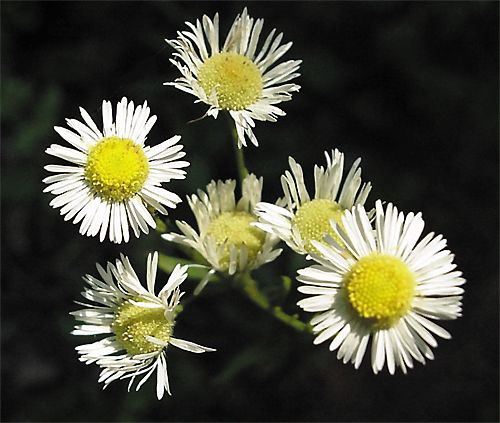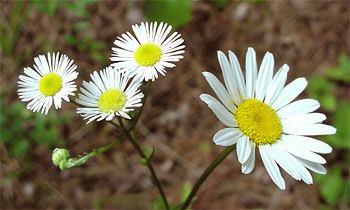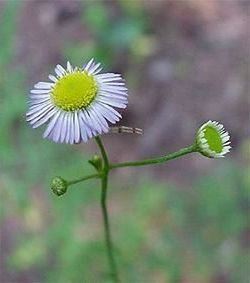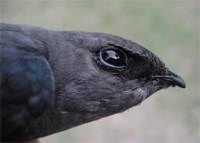|
|
|||
|
THIS WEEK at HILTON POND |
|
One plant that almost any visitor to Hilton Pond Center can identify is the Ox-eye Daisy, a common wildflower famous for an ability to tell the fortune of young lovers who denude its flower head while saying, "She loves me, she loves me not." These nervous lovers usually believe they are plucking petals one-by-one from the daisy, but as true composite flowers, daisies have no obvious petals. What the amorous inquisitors teally remove are sterile "ray flowers" whose function is to attract insects that cross-pollinate the nectar- and pollen-rich disk flowers at the daisy's center.  Since Ox-eye Daisy bears only about 20 ray flowers, an impatient lover is able to arrive at a verdict fairly quickly, but imagine his frustration if he mistakes a Daisy Fleabane flower for an Ox-eye Daisy. Daisy Fleabane resembles the true daisy, but its half-inch flowers are only half the diameter and it has two to four times as many ray flowers--up to a hundred in some specimens. As illustrated in the photo below, Daisy Fleabane's ray flowers tend to be narrower than those of Ox-eye Daisy, but otherwise these composite flowers are indeed similar--even though the fleabane has no verifiable fortune-telling skills. Several closely related composites are called "Daisy Fleabane," but perhaps most common in the Carolina Piedmont is Erigeron annuus, whose scientific name accurately indicates it is an annual plant. (Erigeron comes from Greek words meaning "early" and "old man," E. annuus grows prolifically in fallow fields, meadows, and along roadsides as a "winter annual"; i.e., the seeds germinate in summer or late fall and form a basal rosette of leaves that in the following spring or summer give rise to a stem and blossoms and a new seed crop--after which the plant dies. Although Daisy Fleabane usually has white ray flowers--a yellow species occurs in the West--it's not uncommon to find Carolina specimens that are pinkish or pale lavender (below left). Botanists are undecided about whether the pigment is influence by minerals in the soil, genetics, or some other factor, but we've noticed the non-white forms seem more common in shadier habitats.
Botanists aren't the only creatures who have figured out that Daisy Fleabane attracts all kinds of little critters. When we were re-sizing the lavender fleabane photo (above left) to be used in this week's essay, we spotted something we had overlooked while taking the photograph: sticking out to the right from beneath the ray flowers are two long slender structures. Not part of the flower, these are two of the thin but powerful legs of a Crab Spider, which uses them to grasp an insect that happens to land on its adopted blossom. How interesting it is that Daisy Fleabane--employed to keep away fleas--does a far better job attracting insects, their predators, and curious naturalists at Hilton Pond Center. If you enjoy "This Week at Hilton Pond," please help Support Hilton Pond Center for Piedmont Natural History. It's painless, and YOU can make a difference! You may wish to consult our Index of all nature topics covered since February 2000. |

 which allude to the plant's tendency to blossom in late spring and to form fuzzy white seed heads while still producing new flowers.) Other fleabanes commonly found in the Carolinas are E. pulchellus (also called "Robin's Plantain"), E. canadensis (AKA Horse weed, Hogweed or Butterweed), and E. strigosus; they are identified in part by differences in leaf shape and other growth aspects. Daisy Fleabane has an even wider distribution than the common Ox-eye Daisy, occurring naturally in every state east of the Rockies and now introduced into nearly all the rest of the lower 48. Although all these fleabanes produce blooms that are pleasing to the eye of the wandering flowerphile, they are held in disdain by some farmers who consider them to be invasive in agricultural plots.
which allude to the plant's tendency to blossom in late spring and to form fuzzy white seed heads while still producing new flowers.) Other fleabanes commonly found in the Carolinas are E. pulchellus (also called "Robin's Plantain"), E. canadensis (AKA Horse weed, Hogweed or Butterweed), and E. strigosus; they are identified in part by differences in leaf shape and other growth aspects. Daisy Fleabane has an even wider distribution than the common Ox-eye Daisy, occurring naturally in every state east of the Rockies and now introduced into nearly all the rest of the lower 48. Although all these fleabanes produce blooms that are pleasing to the eye of the wandering flowerphile, they are held in disdain by some farmers who consider them to be invasive in agricultural plots. Fleabanes get their common name from an old belief that they repelled fleas and other pestiferous insects. Early European settlers in North America stuffed mattresses with fleabane and hung clusters of plants in their cabins to drive out fleas. The custom persisted for generations, even though Daisy Fleabane appears to have no insect-repelling ability whatsoever. In fact, the plant ATTRACTS insects--not only pollinators but also tiny herbivores that nibble away the ray flowers and leave only the central disk. Here at Hilton Pond Center, we like to go out into our meadows and spend time checking out the Daisy Fleabane flower heads, which typically have their own fascinating complement of tiny bees, flies, and beetles in search of nectar.
Fleabanes get their common name from an old belief that they repelled fleas and other pestiferous insects. Early European settlers in North America stuffed mattresses with fleabane and hung clusters of plants in their cabins to drive out fleas. The custom persisted for generations, even though Daisy Fleabane appears to have no insect-repelling ability whatsoever. In fact, the plant ATTRACTS insects--not only pollinators but also tiny herbivores that nibble away the ray flowers and leave only the central disk. Here at Hilton Pond Center, we like to go out into our meadows and spend time checking out the Daisy Fleabane flower heads, which typically have their own fascinating complement of tiny bees, flies, and beetles in search of nectar.

